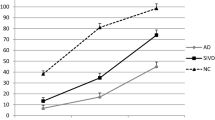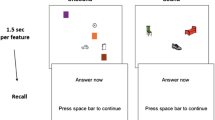Abstract
According to the new research criteria for the diagnosis of Alzheimer’s disease, episodic memory impairment, not significantly improved by cueing, is the core neuropsychological marker, even at a pre-dementia stage. The FCSRT assesses verbal learning and memory using semantic cues and is widely used in Europe. Standardization values for the Italian population are available for the colored picture version, but not for the 16-item printed word version. In this study, we present age- and education-adjusted normative data for FCSRT-16 obtained using linear regression techniques and generalized linear model, and critical values for classifying sub-test performance into equivalent scores. Six scores were derived from the performance of 194 normal subjects (MMSE score, range 27–30, mean 29.5 ± 0.5) divided per decade (from 20 to 90), per gender and per level of education (4 levels: 3–5, 6–8, 9–13, >13 years): immediate free recall (IFR), immediate total recall (ITR), recognition phase (RP), delayed free recall (DFR), delayed total recall (DTR), Index of Sensitivity of Cueing (ISC), number of intrusions. This study confirms the effect of age and education, but not of gender on immediate and delayed free and cued recall. The Italian version of the FCSRT-16 can be useful for both clinical and research purposes.


Similar content being viewed by others
References
Kerchner GA, Deutsch GK, Zeineh M, Dougherty RF, Saranathan M, Rutt BK (2012) Hippocampal CA1 apical neuropil atrophy and memory performance in Alzheimer’s disease. Neuroimage 63:194–202
Dubois B, Feldman HH, Jacova C, Dekosky ST, Barberger-Gateau P, Cummings J, Delacourte A, Galasko D, Gauthier S, Jicha G, Meguro K, O’Brien J, Pasquier F, Robert P, Rossor M, Salloway S, Stern Y, Visser PJ, Scheltens P (2007) Research criteria for the diagnosis of Alzheimer’s disease: revising the NINCDS-ADRDA criteria. Lancet Neurol 6:734–746
Dubois B et al (2014) Advancing research diagnostic criteria for Alzheimer’s disease: the IWG-2 criteria. Lancet Neurol 13:614–629
Grober E, Buschke H (1987) Genuine memory deficits in dementia. Dev Neuropsychol 3:13–16
Grober E, Merling A, Heimlich T, Lipton RB (1997) Comparison of selective reminding and free and cued selective reminding in the elderly. J Clin Expl Neuropsychol 19:643–654
Grober E, Buschke H, Crystal H, Bang S, Dresner R (1998) Screening for dementia by memory testing. Neurology 38:900–903
Petersen RC, Smith GE, Ivnik R, Tangalos EG, Schaid DJ, Thibodeau SN, Kokmen E, Waring SC, Kurland LT (1995) Apolipoprotein E status as a predictor of the development of Alzheimer’s disease in memory-impaired individuals. JAMA 273:1274–1278
Sarazin M, Berr C, De Rotrou J, Fabrigoule C, Pasquier F, Legrain S, Michel B, Puel M, Volteau M, Touchon J, Verny M, Dubois B (2007) Amnestic syndrome of the medial temporal type identifies prodromal AD: a longitudinal study. Neurology 69:1859–1867
Ferris SH, Aisen PS, Cummings J, Galasko D, Salmon DP, Schneider L, Sano M, Whitehouse PJ, Edland S, Thal LJ (2006) ADCS prevention instrumentation project: overview and initial results. Alzheimer Dis Assoc Disord 20:S109–S123
Grober E, Lipton RB, Hall C, Crystal H (2000) Memory impairment on free and cued selective reminding predicts dementia. Neurology 54:827–832
Auriacombe S, Helmer C, Amieva H, Berr C, Dubois B, Dartigues JF (2010) Validity of the free and cued selective reminding test in predicting dementia: the 3C study. Neurology 74:1760–1767
Traykov L, Baudic S, Raoux N, Latour F, Rieu D, Smagghe A, Rigaud AS (2005) Patterns of memory impairment and perseverative behavior discriminate early Alzheimer’s disease from subcortical vascular dementia. J Neurol Sci 75:229–230
Grober E, Hall C, Sanders A, Lipton RB (2008) Free and cued selective reminding distinguishes Alzheimer’s disease from vascular dementia. J Am Geriatr Soc 56:944–946
Pasquier F, Grymonprez L, Lebert F, Van der Linden M (2001) Memory impairment differs in frontotemporal dementia and Alzheimer’s disease. Neurocase 7:161–171
Pillon B, Deweer B, Agid Y, Dubois B (1993) Explicit memory in Alzheimer’s, Huntington’s, and Parkinson’s diseases. Arch Neurol 50:374–379
Pillon B, Deweer B, Michon A, Malapani C, Agid Y, Dubois B (1994) Are explicit memory disorders of progressive supranuclear palsy related to damage to striatofrontal circuits? Comparison with Alzheimer’s, Parkinson’s, and Huntington’s diseases. Neurology 44:1264–1270
Costa A, Monaco M, Zabberoni S, Peppe A, Perri R, Fadda L, Iannarelli F, Caltagirone C, Carlesimo GA (2014) Free and cued recall memory in Parkinson’s disease associated with amnestic mild cognitive impairment. PLoS One 9(1):e86233. doi:10.1371/journal.pone.0086233
Sarazin M, Chauvire V, Gerardin E, Colliot O, Kinkingnehun S, de Souza LC, Hugonot-Diener L, Garnero L, Lehericy S, Chupin M, Dubois B (2010) The amnestic syndrome of hippocampal type in Alzheimer’s disease: an MRI study. J Alzheimers Dis 22:285–294
Deweer B, Lehericy S, Pillon B, Baulac M, Chiras J, Marsault C, Agid Y, Dubois B (1995) Memory disorders in probable Alzheimer’s disease: the role of hippocampal atrophy as shown with MRI. J Neurol Neurosurg Psychiatry 58:590–597
Rami L, Solé-Padullé C, Fortea J, Bosch B, Lladò A, Antonell A, Olives J, Castellvì M, Bartres-Faz D, Sanchez-Valle R, Molinuevo JL (2012) Applying the new research diagnostic criteria: MRI findings and neuropsychological correlations of prodromal AD. Int J Geriatr Psychiatry 27:127–134
Wagner M, Wolf S, Reischies FM, Daerr M, Wolfsgruber S, Jessen F, Popp J, Maier W, Hüll M, Frölich L, Hampel H, Perneczky R, Peters O, Jahn H, Luckhaus C, Gertz HJ, Schröder J, Pantel J, Lewczuk P, Kornhuber J, Wiltfang J (2012) Biomarker validation of a cued recall memory deficit in prodromal Alzheimer disease. Neurology 78:379–386
Carlesimo GA, Perri R, Caltagirone C (2011) Category cued recall following controlled encoding as a neuropsychological tool in the diagnosis of Alzheimer’s disease: a review of the evidence. Neuropsychol Rev 21:54–65
Buschke H (1984) Cued recall in amnesia. J Clin Neuropsychol 6:433–440
Van der Linden M, Coyette F, Poitrenaud J, Kalafat M, Calicis F, Wyns C, et al (2004) L’épreuve de rappel libre/rappel indicé à 16 items (RL/RI-16). In: Van der Linden M (ed). L’évaluation des troubles de la mémoire. Marseille: Solal. Van Der Linden et les membres du GREMEM eds. L’evaluation des troubles de la mémoire. Solal eds., Marseillex, pp 25–48
Peña-Casanova J, Gramunt-Fombuena N, Quinones-Ubeda S, Sanchez-Benavides G, Aguilar M, Badenes D, Molinuevo JL, Robles A, Barquero MS, Payno M, Antunez C, Martinez-Parra C, Frank-Garcia A, Fernandez M, Alfonso V, Sol JM, Blesa R (2009) Spanish Multicenter Normative Studies (NEURONORMA Project): norms for the Rey-Osterrieth complex figure (copy and memory), and free and cued selective reminding test. Arch Clin Neuropsychol 24:371–393
Ivnik RJ, Smith GE, Lucas JA, Tangalos EG, Kokmen E, Petersen RC (1997) Free and cued selective reminding test: MOANS norms. J Clin Exp Neuropsychol 19:676–691
Frasson P, Ghiretti R, Catricalà Pomati S, Marcone A, Parisi L, Rossini PM, Cappa SF, Mariani C, Vanacore N, Clerici F (2011) Free and cued selective reminding test: an Italian normative study. Neurol Sci 32:1057–1062
Folstein MF, Folstein SE, McHugh PR (1975) ‘Mini-mental state’. A practical method for grading the cognitive state of patients for the clinician. J Psychiatr Res 12:189–198
Measso G, Cavarzeran F, Zappalà G, Lebowitz BD, Crook TH, Pirozzolo FJ, Amaducci LA, Massari D, Grigoletto F (1993) The Mini-mental State Examination: normative study of an Italian random sample. Dev Neuropsychol 9:77–95
Grigoletto F, Zappalà G, Anderson DW, Lebowitz BD (1999) Norms for the Mini-Mental State Examination in a healthy population. Neurology 53:315–320
Magni E, Binetti G, Bianchetti A, Rozzini R, Trabucchi M (1996) Mini-mental State Examination: a normative study in Italian elderly population. Eur J Neurol 41:198–202
Crum RM, Anthony JC, Bassett SS, Folstein MF (1993) Population based norms for the Mini-Mental State Examination by age and educational level. JAMA 269:2386–2391
Capitani E, Laiacona M (1997) Composite neuropsychological batteries and demographic correction: standardization based on equivalent scores, with a review of published data. J Clin Exp Neuropsychol 19:795–806
Spinnler H, Tognoni G (1987) Standardizzazione e taratura italiana di test neuropsicologici. Ital J Neurol Sci 8(Suppl):1–120
Amieva H, Carcaillon L, Rouze L’Alzit-Schuermans P, Millet X, Dartigues JF, Fabrigoule C (2007) Test de rappel libre/rappel indicé à 16 items : normes en population générale chez des sujets âgés issues de l’étude des 3 cités. Rev Neurol 163:205–221
Petersen RC, Smith GE, Kokmen E, Ivnik RJ, Tangalos EG (1992) Memory function in normal aging. Neurology 42:396–401
Wiederholt WC, Cahn D, Butters NN, Salmon DP, Kritz-Silverstein D, Barrett-Connor E (1993) Effects of age, gender, and education on selected neuropsychological tests in an elderly community cohort. J Am Geriatr Soc 41:639–647
Paivio A, Csapo K (1973) Picture superiority in free recall: imagery or dual coding? Cogn Psychol 5:176–206
Parra MA, Abrahams S, Logie RH, Méndez LG, Lopera F, Della Sala S (2010) Visual short-term memory binding deficits in familial Alzheimer’s disease. Brain 133:2702–2713
Bird CM, Chan D, Hartley T, Pijnenburg YA, Rossor MN, Burgess N (2010) Topographical short-term memory differentiates Alzheimer’s disease from frontotemporal lobar degeneration. Hippocampus 20:1154–1169
Conflict of interest
All authors disclose that there is no actual or potential conflict of interest including any financial, personal, or other relationship with other people or organizations that could inappropriately influence their work.
Author information
Authors and Affiliations
Corresponding author
Electronic supplementary material
Below is the link to the electronic supplementary material.
Rights and permissions
About this article
Cite this article
Girtler, N., De Carli, F., Amore, M. et al. A normative study of the Italian printed word version of the free and cued selective reminding test. Neurol Sci 36, 1127–1134 (2015). https://doi.org/10.1007/s10072-015-2237-7
Received:
Accepted:
Published:
Issue Date:
DOI: https://doi.org/10.1007/s10072-015-2237-7




